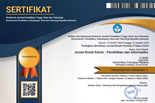Pengembangan Aplikasi Android Menggunakan Integrated Development Environment (Ide) App Inventor-2
Abstract
Many Integrated Development Environment (IDE) can be used to create Android Apps. Android Studio with Java programming language is an IDE and native programming language that is officially supported by Google. As a supported IDE, AS becomes the best IDE that can be used to build apps. Nevertheless, many novice programmers find it difficult to get started especially by starting a new programming concept for mobile devices. Android Studio is also known as an IDE that requires a high specs computer requirement and also has sophisticated features. This research purposed to develop applications with IDEs that are more user-friendly and more emphasize the big concept of programming without much difficulty regarding compiling the program code and also the complexity of IDE as well as Android Studio. The IDE used in this study is App Inventor 2 (AI2), a cloud-based IDE managed by the Massachusetts Institute of Technology (MIT). The next goal is to test the capabilities of the application by conducting Blackbox Testing and User Testing. In this research has been developed an app called Receptionist that is used to test the ability of the codes generated by AI2. The results show that AI2 can be used to build complex applications such as Text Message Service (SMS) broadcasting, performing local database queries and retrieving data on the server. However, some features such as database processing should run in the background still run on the UI thread, thereby reducing the user experience when Application Not Responding (ANR) occurs.
Keywords: App Inventor 2, Android Application, Cloud Programming, visual programming
Full Text:
PDF (Bahasa Indonesia)References
Munoz, R., Barcelos, T., Villarroel, R., Becerra, C., Noel, R., & Ponce, F. (2017). Using app inventor to change perceptions about software engineering. Proceedings - International Conference of the Chilean Computer Science Society, SCCC. https://doi.org/10.1109/SCCC.2016.7836023
Papadakis, S., Kalogiannakis, M., Orfanakis, V., & Zaranis, N. (2017). The appropriateness of scratch and app inventor as educational environments for teaching introductory programming in primary and secondary education. International Journal of Web-Based Learning and Teaching Technologies, 12(4), 58–77. https://doi.org/10.4018/IJWLTT.2017100106
Papadakis, S., & Orfanakis, V. (2017). The Combined Use of Lego Mindstorms NXT and App Inventor for Teaching Novice Programmers. International Conference on Educational Robotics, EDUROBOTICS 2016, 560. https://doi.org/10.1007/978-3-319-55553-9
Sauro, J., & Lewis, J. (2012). Quantifying the User Experience Practical Statistics for User Research. Elsevier Inc.
Sugiyono. (2009). Metode Penelitian Kuantitatif, Kualitatif dan RnD (8th ed.). Bandung: Penerbit Alfabeta.
Zhang, D., & Adipat, B. (2005). Challenges, Usability, Methodologies, and Issues in the Usability Testing of Mobile Applications. International Journal of Human-Computer …, 18(3), 293–308. https://doi.org/10.1207/s15327590ijhc1803
DOI: https://doi.org/10.21107/edutic.v4i1.3229
Refbacks
- There are currently no refbacks.
Copyright (c) 2017 Endar Suprih Wihidayat, Endar Suprih Wihidayat

This work is licensed under a Creative Commons Attribution 4.0 International License.
Indexed by:
 J. Ilm. Edutic is licensed under a Creative Commons Attribution 4.0 International License.
J. Ilm. Edutic is licensed under a Creative Commons Attribution 4.0 International License.















